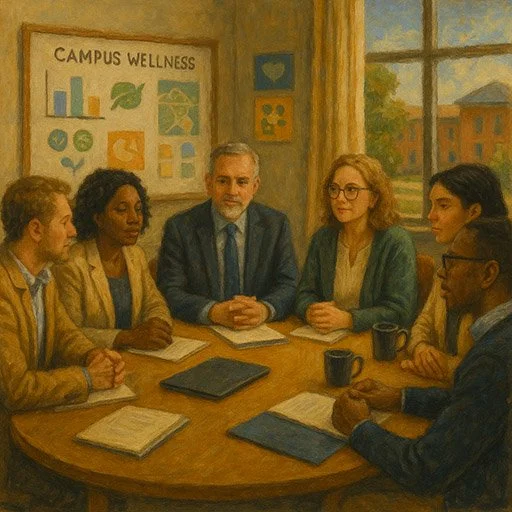College Mental Health Crisis: Solutions for Students
Author: Dr. Timothy Rubin, PhD in Psychology
Originally Published: January 2025
Last Updated: January 2025

The college mental health crisis affects nearly half of all students, requiring comprehensive solutions from both institutions and individuals.
Contents
- The Scope of the Crisis
- College-Specific Mental Health Challenges
- Traditional vs. Digital Solutions
- Age-Appropriate Treatment for Young Adults
- AI and Digital Mental Health Tools
- What Students Can Do
- What Universities Can Do
- Future Policy and Practice
- FAQ: College Mental Health Resources
The college mental health crisis has reached unprecedented levels. Nearly half of students report anxiety or depression, and crises like suicidal thoughts are increasingly common on campuses nationwide.
A recent University of Michigan study found that 44% of students felt depressed and 37% felt anxious, with 15% having seriously considered suicide. These aren't just statistics—they represent millions of young adults struggling during what should be transformative years.
The good news? Evidence-based solutions exist. From campus counseling improvements to innovative digital tools, comprehensive approaches can help students thrive academically and personally.
The Scope of the Crisis

Mental health challenges have surged dramatically among college students over the past decade.
The numbers paint a sobering picture. Time magazine analysis revealed that 41% of surveyed students had depression and 36% had anxiety in 2022-23. Another survey noted 60% of students experienced "overwhelming" anxiety.
These rates have surged since 2013—one study found college depression up 134% and anxiety up 110% by 2021. Pre-COVID, 90% of counseling centers already saw growing demand, and waitlists have lengthened significantly.
On the positive side, more symptomatic students are seeking help. Over 60% now receive therapy or counseling, though only about a third of those in need get support each year.
College-Specific Mental Health Challenges
College life brings unique stresses during a vulnerable developmental period. Emerging adulthood (ages 18-25) is a peak risk period for new mental health problems, with roughly 63% of lifetime mental disorders starting by age 25.
Students face academic pressure, financial worries, and major life transitions—living independently, navigating relationships, and managing heavy coursework alongside jobs or family obligations. This coincides with ongoing brain development and identity formation.
Environmental and Social Factors
Campus culture significantly impacts student wellbeing. Academic stress, sleep deprivation, social media pressures, and substance access all contribute to mental health challenges.
Marginalized students face additional hurdles. Research shows students of color are less likely to seek help—46% of White students sought counseling versus 26% of Black students. LGBTQ+ and first-generation students also encounter unique stressors.
Barriers like stigma, cost, time constraints, and the belief they should "handle it myself" discourage help-seeking despite improving attitudes toward mental health treatment.
Traditional vs. Digital Solutions
Universities offer various mental health resources, each with distinct advantages and limitations.
Campus Resources
Campus counseling centers provide free therapy and psychiatry services but are often overwhelmed. Even before COVID, 90% of directors reported increased demand, and many now have multi-week waitlists.
Off-campus therapy and telehealth platforms can offer faster access but may involve cost or insurance barriers.
Digital Mental Health Solutions

Digital mental health tools provide 24/7 support when traditional campus resources aren't available.
Digital interventions are increasingly filling gaps in traditional care. A 2025 meta-analysis found digital interventions produce moderate improvements in student anxiety and depression with effect sizes around d≈0.5.
Key digital solutions include:
- Online therapy platforms connecting students to licensed counselors remotely
- Mental health apps offering CBT exercises, mood tracking, and stress management
- Mindfulness and meditation apps that significantly lower stress and anxiety
- AI chatbots providing 24/7 supportive conversations and coping strategies
Digital tools help bypass long waits and stigma while meeting students where they are—on their smartphones. Most college-age students are open to tech solutions and appreciate evidence-based features like thought logs and progress tracking.
Age-Appropriate Treatment for Young Adults
Young adults have different treatment needs than older populations. Effective interventions must match their developmental stage and lifestyle.
Engagement and Technology
College students prefer interactive, tech-savvy approaches. Apps and online platforms deliver therapy content in familiar formats, while multimedia elements increase engagement for this generation.
Peer support proves especially powerful. Studies show peer-led programs are highly effective—"peers may be the single most potent source of influence" on each other's wellbeing. Many campuses now offer peer counseling and mentorship programs.
Developmental Focus
Therapies often integrate life-skill training. CBT for students might address academic stress or test anxiety, while mindfulness-based approaches teach focused breathing to interrupt rumination.
Shorter, flexible therapy formats work better than traditional 12+ session models. Brief interventions (4-8 sessions) can help mild symptoms, while drop-in counseling and workshops provide accessible support without full therapy commitments.
AI and Digital Mental Health Tools
Artificial intelligence represents a new frontier in college mental health support, offering innovative ways to expand access and personalization.
AI Chatbots and Assistants
AI-powered chatbots simulate therapeutic conversations with impressive results. A study of one college-focused chatbot found large drops in users' depression and anxiety scores after just one week of use.
These tools offer 24/7 availability on students' phones, providing immediate support when stress hits. Features include mood check-ins, coping exercises, and resource recommendations dynamically tailored to individual needs.
Personalized Support
AI can analyze responses and customize interventions. For example, AI-guided meditation apps can generate custom scripts based on specific worries or triggers that students mention.
Some platforms use algorithms to adjust difficulty or delivery mode depending on what engages each student most. This personalization helps match interventions to individual preferences and needs.
Predictive and Preventive Applications
Emerging AI applications include predictive analytics that might identify students at risk by analyzing anonymous data patterns, allowing for earlier intervention. Ethical safeguards are critical, but the preventive potential is significant.
While AI should augment rather than replace professional care, thoughtful deployment helps stretch limited campus resources and meets students where they are—online and on-demand.
What Students Can Do
Recognize warning signs early. Persistent sadness, anxiety, withdrawal, or changes in sleep and appetite warrant attention. Many college health centers offer online screening tools to gauge mental health status.
Seek Help Before Crisis
If stress feels unmanageable, reach out before reaching a crisis point. Contact your counseling center or health services—many offer online intake forms. If waitlists are long, ask about teletherapy referrals or off-campus providers.
Utilize Multiple Resources
Beyond counseling centers, explore peer support groups, academic accommodations through disability services, campus hotlines, and evidence-based apps for anxiety management and mood tracking.
Even short mindfulness sessions (5-10 minutes) can reduce anxiety immediately. Many universities offer exercise classes or meditation sessions specifically for students.
Build Healthy Routines
Maintain regular sleep, exercise, and nutrition—these profoundly impact mood. Join campus clubs or study groups to build community, as isolation worsens depression.
It's okay to talk about stress and ask for support. Sharing concerns with trusted friends or family can significantly lighten the emotional load.
What Universities Can Do

Universities need comprehensive, campus-wide approaches to address the mental health crisis effectively.
Expand and Improve Services
Hire more counselors and mental health staff to reduce wait times. Follow expert recommendations to avoid strict session caps or burdensome fees on student health plans.
Some colleges use student health fees to guarantee unlimited counseling for enrolled students, ensuring financial barriers don't prevent access.
Train the Campus Community
Implement Mental Health First Aid programs for faculty, staff, and resident advisors. UNC-Chapel Hill trained over 900 campus community members to recognize and respond to student distress.
This creates a network of informed supporters who can guide students to appropriate help before situations escalate.
Prevention and Peer Programs
Offer resilience and stress-management workshops. Embed mental wellness into curricula through mandatory "Wellness 101" courses or first-year seminars on life skills.
Invest in peer counseling and mentoring programs. Peers can be "a more approachable first step" than adult counselors, providing on-call support or drop-in "wellness hours."
Promote Digital Tools and Build Inclusive Culture
Publicize vetted mental health apps and teletherapy services. Some colleges partner with platforms to provide free or discounted access to students.
Ensure support services are culturally competent by hiring diverse counselors and creating safe spaces for marginalized groups. Feeling understood significantly increases help-seeking behavior.
Future Policy and Practice
Experts urge evidence-based, systemic changes to address the crisis comprehensively.
Data-Driven Funding and Holistic Approaches
Continue expanding national surveys to track trends and justify resource allocation. Use data to advocate for mandatory health fees or federal grants to hire counselors.
The National Academies recommends an "all hands" strategy where every department considers mental health in policies—from academic advisors routinely checking stress levels to athletics departments training coaches in mental health awareness.
Inclusive Care and Research
Policies must ensure equitable access through multilingual counselors, programs for first-generation and minority students, and support for LGBTQ+ and international students.
Invest in campus mental health research to identify "what works." Very few programs have been rigorously tested in diverse college settings. Universities can partner with researchers to evaluate new interventions and share results.
The emerging consensus is clear—improving student mental health requires broad, systemic efforts that go far beyond treating individual symptoms.
Moving Forward Together
The college mental health crisis is serious, but it's not insurmountable. Evidence-based solutions exist at individual, institutional, and policy levels.
Students don't have to suffer in silence. Whether through campus counseling, peer support, digital tools, or professional therapy, help is available in multiple forms.
Universities can create comprehensive support systems that catch students before they reach crisis points. The future lies in combining traditional therapeutic approaches with innovative digital solutions and campus-wide wellness cultures.
Each step toward better mental health support—whether taken by an individual student or implemented by an institution—contributes to a healthier, more supportive environment for all.
-Tim, Founder of Wellness AI
About the Author
Dr. Timothy Rubin holds a PhD in Psychology with expertise in cognitive science and AI applications in mental health. His research has been published in peer-reviewed psychology and artificial intelligence journals. Dr. Rubin founded Wellness AI to make evidence-based mental health support more accessible through technology.
FAQ: College Mental Health Resources
How serious is the college mental health crisis?
Very serious. Nearly half of students experience anxiety or depression, with about 1 in 7 considering suicide each year. Rates have climbed dramatically over the last decade, affecting campuses nationwide.
What mental health resources are available for college students?
Students can access campus counseling centers, off-campus therapy, digital mental health apps, peer support groups, and crisis hotlines. Many schools also offer workshops and stress management programs.
Can digital mental health tools really help college students?
Yes, research shows digital interventions produce moderate improvements in student anxiety and depression. Apps and AI chatbots provide 24/7 support when traditional services aren't available.
What should I do if my campus counseling center has long waitlists?
Consider off-campus therapists, teletherapy platforms, evidence-based mental health apps, peer support groups, or crisis hotlines. Don't give up—multiple options exist beyond waiting rooms.
How can universities better support student mental health?
Universities should hire more counselors, train campus community members in Mental Health First Aid, offer prevention programs, and create inclusive, culturally competent services for all students.
Are peer support programs effective for college mental health?
Yes, research shows peers can be "the single most potent source of influence" on student wellbeing. Peer counseling and mentorship programs are often more approachable than traditional therapy.